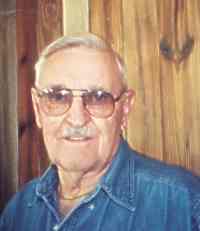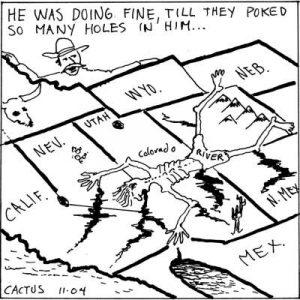Review by Steve Voynick
Leadville – November 2004 – Colorado Central Magazine
LEADVILLE – The Struggle to Revive an American Town
by Gillian Klucas
published in 2004 by Island Press
ISBN 1-55963-385-9
GLANCING AT THE SUBTITLE of Gillian Klucas’ first book, I assumed that this 292-page volume would address Leadville’s economic development, or lack of it, since the demise of the Climax Mine brought economic disaster two decades ago. The cover art, which depicts the front of a wooden filing-cabinet drawer with a tab marked “Leadville,” did nothing to either support or dissuade this assumption.
However, the book actually focuses on another topic–the usually contentious, sometimes bitter, and occasionally laughable relationship between Leadville and the federal Environmental Protection Agency. Many who lived through Leadville’s “EPA era” harbor emotional memories of Yak Tunnel “blow-outs” that turned the Arkansas River orange for many miles downstream, “EPA: GO TO HELL” bumper stickers, and “ditch-riders” who regularly drove up East Fifth Street to scream obscenities at EPA work crews (a few ditch-riders still pursue this curious calling today).
But Klucas quickly establishes that the Leadville-EPA story is far more serious. Sixteen square miles of the Leadville Mining District and California Gulch were among the most heavily polluted areas in the West when the EPA designated Leadville a Superfund site on September 8, 1983. For Leadville, then desperately trying to develop tourism, the timing was a nightmare. The last thing Leadville needed was negative national publicity about its heavy-metal pollution.
The author explains that, at the time, neither the EPA nor the Superfund program were well-oiled pieces of federal machinery. Only recently established, Superfund had no precedents to follow and the courts were still debating its basic legality along with such other critical issues as social responsibility for mine pollution and financial responsibility for cleanup costs. Meanwhile, the EPA itself, racked by internal conflict, was little more than a revolving door of controversial, politically-appointed administrators.
Even before a swarm of EPA contractors had collected countless water and soil samples in Leadville, the EPA identified and sued 13 “potentially responsible parties,” or PRPs. Twelve of these PRPs were mining or land-holding companies. The sole individual was Bob Elder, a respected and well-known Leadville resident whose biggest “crime” seems to have been owning and trying to consolidate numerous, inactive mining claims that his family had passed down for generations.
The Leadville-EPA relationship quickly deteriorated into a bitter confrontation between “us and them,” with Carl Miller and Ken Chlouber, then county commissioners, leading and rallying the home team. Klucas provides colorful and interesting insight into the personalities of Miller and Chlouber, current county commissioner Jim Martin, and retired Leadville vet erinarian and rancher Bernard “Doc” Smith, all of whom played important roles in the developing drama.
IN THE BEGINNING, even the EPA project managers believed the agency would basically “clean up California Gulch” and get out of Leadville within five years. But a decade later, with the EPA more entrenched then ever and with no end to the cleanup in sight, Ken Chlouber, by then a state senator, was more enraged then ever. Speaking at a national political conference in Denver, a frustrated Chlouber explained exactly what he’d like to do with the EPA: “My suggestion is to simply hang [an EPA employee] at each end of town.”
Yet despite the high emotions and building tensions, Klucas, through no fault of her own, cannot provide readers with an exciting account of a grand, climactic battle. Instead, she tells how Leadville, finally realizing that it could never force the EPA out, grew weary of fighting, while an influx of new residents raised louder voices in favor of cooperation. Among them was former Leadville mayor Chet Gaede, who recently wrote, “It seems to me that we get more [done] by working with other organizations that have interests in our community than we do by calling them names and insulting them.”
Klucas, who spent a year in Leadville to gather material for her book, has produced a very readable account of a difficult time in Leadville’s recent history. To her credit, she maintains a high level of journalistic objectivity in her treatment of complex issues that have polarized the viewpoints of many individuals. Her book makes sense out of 20 years of disjointed and confusing court hearings, mass lawsuits, technical reports, and endless negotiations, while dispelling myths and misconceptions along the way.
But the book does have its shortcomings. The author’s unfamiliarity with geology and the history and technical aspects of mining and milling reveals itself in awkward and sometimes erroneous uses of related terminology. As an example, Klucas notes that “the [flotation-separation] process was less efficient than smelting”–an illogical comparison of two ore-treatment processes that serve entirely different purposes. She also includes flotation in her discussion of ore-processing methods of the 1870s, even though it would not appear in mining camps for another 30 years.
And I did note several additional, annoying errors. The approximate length of the Colorado Mineral Belt is 150 miles, not 350 miles as the author claims. She incorrectly ends the Korean War in 1952, then has the Leadville Elks occupying the Tabor Opera House in 1982, when the Elks had actually sold that historic building decades earlier. And Klucas tells of Carl Miller driving a “battered, tan 1970s Buick pickup.” I hope that Carl still has that vehicle, since it would be the one and only truck that Buick has ever made since 1917.
Considering the complex nature of the Leadville-EPA relationship, and the author’s extensive use of personal quotes and references to state and federal policies, footnotes would have been much more useful to serious readers than her brief two-and-a-half pages of general endnotes.
So after 21 years and $100 million in cleanup costs, when will the Leadville-EPA story end? Klucas uses the law of diminishing returns to explain why no one knows yet. “If 85 percent of the cleanup has been done, at a cost of an estimated $100 million,” she writes, “is cleaning up the last 15 percent, at what some EPA officials predict would cost another $100 million, worth it, particularly with so many other abandoned mining sites remaining throughout the West?”
Klucas’ book left me pondering other questions. Should Leadville have cooperated with the EPA from the start? Or did it first have to establish itself as a force to be reckoned with in order to gain later EPA concessions? And when will the EPA leave Leadville? That answer, Klucas believes, will be known only when someone can answer this more perplexing question: How clean is clean enough?
I recommend Leadville: The Struggle to Revive an American Town to any reader interested in putting the Leadville-EPA experience into historical perspective.
–Steve Voynick



